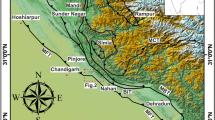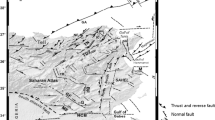Abstract
The paper addresses the Late Cenozoic fault tectonics and the stress state of the Earth’s crust within the Mongolian microplate, embracing Central and Western Mongolia. We analyze the results of reconstructing the stress fields and the tectonic deformations in the zones of active faulting, located at the uplands and in the intermountain trenches, which bound the microplate (Mongolian Altai; Gobi Altai; Dolinoozersk trough; Khan-Taishir-Nuruu, Khan-Houkhei, and Bolnai uplands) and the Khangai dome. Deformations related with the northeastern general-scale collisional compression are concentrated along the periphery of the Mongolian microplate, and the maximum compression is focused on its western and southern boundaries, thus forming the right- and the left-lateral transpressive structures of the Mongolian and Gobi Altai. The deformations associated with the shortening of the Earth’s crust involve not only the mountain ridges framing the block, but also the intermountain troughs that separate the Gobi and Mongolian Altai from the Khangai dome, and the southern portion of the Khangai Uplift. The diversity in the deformations within the central Khengai region ensues from the coupling of tension caused by the dynamical impact of the mantle anomaly, which is located east of 100°E, with a regional NE compression. Owing to the relatively rigid Khangai block, the deformations are transferred to the northern bound of this structure, namely the seismically active North Khangai fault. The role of compression increases to the west of the zone, where it conjugates with the transpressive structures of the Mongolian Altai. The tension becomes more important in the western part of this zone where the releasing bends are formed. A region characterized by extra tension is localized also to the east of 100° E. In terms of the gradient in the lithosphere thickness and the structure types of the upper crust, the submeridional line running along 100°E is interpreted as the key interblock boundary.
Similar content being viewed by others
References
L. M. Balakina, A. V. Vvedenskaya, N. V. Golubeva, L. A. Misharina, and E. I. Shirokova, Elastic Stress Field of the Earth and Focal Mechanisms of Earthquakes (Nauka, Moscow, 1972) [in Russian].
V. G. Belichenko, L. Z. Reznitsky, N. K. Geletii, and I. G. Barash, “Tuva-Mongolia Terrane (in the context of microcontinents in the Paleoasian ocean),” Geologiya i Geofizika 44(6), 554–565 (2003) [Geol. Geofiz. 44 (6), 531–541 (2003)].
N. A. Bushenkova, S. A. Tychkov, and I. Yu. Kulakov, “Upper Mantle Structure Beneath Central Siberia and Neighboring Regions, from Pp-ptomography,” Geologiya i Geofizika 44(5), 474–490 (2003) [Geol. Geofiz. 44 (5), 453–468 (2003)].
Complex Geophysical and Seismological Investigations in Mongolia (RCAG MAN, Ulaanbaatar-Irkutsk, 2004).
W. D. Cunnihgham, “Cenozoic normal faulting and regional doming in the southern Hangay region, Central Mongolia: implications for the origin of the Baikal rift province,” Tectonophysics 331, 389–411 (2001).
W. D. Cunnihgham, “Structural and topographic characteristics of restraining bend mountain ranges of Altai, Gobi Altai and easternmost Tien Shan. Tectonics of strike-slip restraining and releasing bends,” in Geological Society, London, Special Publications, Ed. by W.D. Cunnihgham and P. Mann (Geological Society of London, London, 2007), Vol. 290, pp. 219–237.
W. D. Cunnihgham, B. F. Windley, D. Dorjnamjaa, et al., “Late Cenozoic transpression in southwestern Mongolia and the Gobi Altai-Tien Shan connection,” Earth Planet. Sci. Lett. 140, 67–81 (1996).
D. Delvaux, K. Tenissen, R. Meier, and N. A. Berzin, “The Buildup Dynamics and the Paleostress during the Formation of the Chuya-Kurai Depression in the Altai Mountains Region: the Tectonic and Climate Control,” Geol. Geofiz. 36(10), 31–51 (1995).
D. Delvaux, “The TENSOR program for paleostress reconstruction: examples from the east African and the Baikal rift zones,” Terra Nova 5(Abstr. Suppl. 1), 216 (1993).
D. Delvaux, R. Moyes, G. Stapel, et al., “Paleostress reconstruction and geodynamics of the Baikal region, Central Asia, Part 2. Cenozoic rifting,” Tectonophysics 282, 1–38 (1997).
E. V. Devyatkin, Cenozoic Inland Asia (Stratigraphy, Geochronology and Correlations) (Nauka, Moscow, 1981) [in Russian].
Earthquakes and Principles of Seismic Regionalization of Mongolia (Nauka, Moscow, 1985) [in Russian].
A. G. Filina, Altai-Sayan. (Catalogues of Supplementary Parameters of the Earthquake Sources. I. Source Mechanisms for the Regions). Earthquakes in USSR in 1989 (Nauka, Moscow, 1993) [in Russian].
A. G. Filina, I. D. Tsibul’chik, and V. I. Muchnaya, Earthquakes of Altai and Sayan. Earthquakes in USSR in 1978 (Nauka, Moscow, 1982) [in Russian].
Geological Map of Mongolia. Scale 1: 1000000, Ed. O. Tomurtogoo (Institute of Geology and Mineral Resources, Mongolian Academy of Sciences, 1999).
S. V. Gol’din and O. A. Kuchai, “Seismic Strain in the Altai-Sayan Active Seismic Area and Elements of Collisional Geodynamics,” Geologiya i Geofizika, 48(7), 692–723 (2007) [Geol. Geofiz. 48 (7), 536–557 (2007)].
S. I. Golenetskii and L. V. Anisimova, Cis-Baikalia (Catalogues of Supplementary Parameters of Strong Earthquakes: I. Source Mechanisms of Earthquakes for the Regions). Earthqiakes in USSR in 1979 (Nauka, Moscow, 1982) [in Russian].
V. Hock, G. Daxner-Hock, H. P. Schmid, D. Badamgarav, W. Frank, G. Furtmuller, O. Montag, R. Barsbold, Y. Khand, and J. Sodov, “Oligocene-Miocene sediments, fossils and basalts from the Valley of Lakes (Central Mongolia) — An integrated study,” in Mitteilungen der Osterreichischen Geologishen Gessellschaft” (Austrian Geological Society, Wien, 1999), Vol. 90, pp. 83–125.
K. G. Levi, A. I. Miroshnichenko, A. V. Parfeevets, et al., “Active Faults and Stress Fields of Mongolia,” in Complex Geophysical and Seismological Investigations in Mongolia, Ed. by I. Dzhurik and T. Dugarmaa (RCAG MAS, IEC SB RAS, Ulaanbaatar-Irkutsk, 2004), p. 88–103.
“Mesozoic and Cenozoic Tectonics and Magmatism of Mongolia,” in Proceedings of Joint Soviet-Mongolian Geological Expedition (Nauka, Moscow, 1975), No. 11, p. 308 [in Russian].
V. V. Mordvinova, A. Deschamps, T. Dugarmaa, et al., “Velocity Structure of the Lithosphere on the 2003 Mongolian-Baikal Transect from SV Waves,” Fiz. Zemli, No. 2, 21–32 (2007) [Izvestiya, Phys. Solid Earth 43 (2), 119–129 (2007)].
A. G. Moskvina, “The Mechanism and the Source Parameters of the January 5, 1967 Mogodskoe Earthquake and Its Aftershocks,” Izv. Akad. Nauk SSSR, Ser. Fizika, No.1, 3–17 (1978).
T. V. Nikolaeva and V. F. Shuvalov, “Major Stages of Sedimentation and Development of the Topographies of Central Mongolia in Mesozoic and Cenozoic,” Vestn. Leningr. Univ., No. 3, 17–21 (1969).
Neotectonics, Geodynamics and Seismic Activity of the Northern Eurasia, Ed. by A. F. Grachev (Probel, Moscow, 2000) [in Russian].
A. V. Parfeevets and V. A. San’kov, The Stress State of the Earth’s Crust and the Geodynamics of the Southwestern Part of the Baikal Rift System (Akademicheskoe Izd. “Geo”, Novosibirsk, 2006) [in Russian].
C. Petit, J. Deverchere, F. Houdry, et al., “Present-Day Stress Field Changes along the Baikal Rift and Tectonic Implications,” Tectonics, 15(6), 1171–1191, 1996.
Yu. L. Rebetskii, O. A. Kuchai, and A. V. Marinin, “Stress-Strain State of the Earth’s Crust in the Altai-Sayan Folded Region before the Chuya (Altai) Earthquake of 2003,” in Problemy tektonofiziki. K sorokaletiyu sozdaniya M. V. Gzovskim laboratorii tektonofiziki v IFZ RAN (The Problems of Geotectonics. On the 40th Anniversary of Foundation by M. V. Gzovskii of the Laboratory of Tectonophysics in IPE RAS) (Izd. IFZ, Moscow, 2008), pp. 245–299 [in Russian].
J.-F. Ritz, D. Bourles, E. T. Brown, et al., “Late Pleistocene to Holocene Slip Rates for the Gurvan Bulag Thrust Fault (Gobi-Altay, Mongolia) Estimated with 10Be Dates,” J. Geoph. Res. 108(B3), 2162 (2003).
V. A. San’kov, A. I. Miroshnitchenko, K. G. Levi, et al., “Cenozoic Stress Field Evolution in the Baikal Rift Zone,” Bull. Centre Rech. Elf Explor. — Prod. Elf Aquitaine, 21(2), 435–455 (1997).
V. A. San’kov and A. V. Parfeevets, “Late Cenozoic Stressed State of Active Fault Zones in Western Mongolia and Tuva,” Dokl. Akad. Nauk 403(6), 796–800 (2005) [Dokl. Earth Sci. 403 (6), 852–855 (2005)].
V. A. San’kov, A. I. Miroshnichenko, K. G. Levi, et al., “Reconstructing the stages in the evolution of the stressed state of the Baikal Rift crust,” in Geophysical studies in the Eastern Siberia at the turn of XXI century (Nauka, Novosibirsk, 1996), p. 126–132 [in Russian].
V. A. San’kov, A. V. Lukhnev, N. A. Radziminovich, et al., “A Quantitative Estimate of Modern Deformations of the Earth’s Crust in the Mongolian Block (Based on GPS-Geodesy and Seismotectonic Data),” Dokl. Akad. Nauk 403(6), 685–688 (2005) [Dokl. Earth Sci. 403 (6), 946–950 (2005)].
V. A. San’kov, A. I. Miroshnichenko, A.V. Parfeevets, et al., “Late Cenozoic State of Stress in the Earth’s Crust of the Khubsugul Region (Northern Mongolia): Field and Experimental Evidence,” Geotektonika, No. 2, 78–90 (2004) [Geotectonics 38 (2), 142–153 (2004)].
Schlupp A., Neotectonique de la Mongolie occidentale analysee a partir de donnees de terrain, sismologiques et satellitares, PhD (Univesite Louis Pasteur de Strasburg, 1996).
Seismotectonics and Seismicity of Cis-Khubsugulia, (Nauka, Novosibirsk, 1993) [in Russian].
A. V. Solonenko, N. V. Solonenko, V. I. Mel’nikova, et al., “Stresses and Movements in the Earthquake Sources in Siberia and Mongolia,” in Seismicity and Seismic Regionalization of the Northern Eurasia (Izd. IFZ RAN, Moscow, 1993), Vol. 1, pp. 113–122 [in Russian].
V. G. Trifonov, O. V. Soboleva, R. V. Trifonov, and G. A. Vostrikov, Recent Geodynamics of the Alpine-Himalayan Collision Belt (GEOS, Moscow, 2002) [in Russian].
R. Vassallo, M. Jolivet, J.-F. Ritz, et al., “Uplift Age and Rates of the Gurvan Bogd System (Gobi-Altay) by Apatite FIssion Track Analysis,” Earth Planet. Sci. Lett. 259, 333–346 (2007).
R. T. Walker, E. Molor, M. Fox, and A. Bayasgalan, “Active Tectonics of an Apparently Aseismic Region: Distributed Active Strike-Slip Faulting in the Hangay Mountains of Central Mongolia,” Geophys. J. Int. 174(3), 1121–1137 (2008).
R. T. Walker, E. Nissen, E. Molor, and A. Bayasgalan, “Reinterpretation of the Active Faulting in Central Mongolia,” Geology 35(8), 759–762 (2007).
T. B. Yanovskaya and V. M. Kozhevnikov, “3D S-wave Velocity Pattern in the Upper Mantle Beneath the Continent of Asia from Rayleigh Wave Data,” Phys. Earth Planet. Inter. 138(3), 263–278 (2003).
L. P. Zonenshain and L. A. Savostin, Introduction to Geodynamics (Nedra, Moscow, 1979) [in Russian].
Author information
Authors and Affiliations
Corresponding author
Additional information
Original Russian Text © A.V. Parfeevets, and V.A. San’kov, 2010, published in Fizika Zemli, 2010, No. 5, pp. 3–14.
Rights and permissions
About this article
Cite this article
Parfeevets, A.V., San’kov, V.A. Late Cenozoic fields of the tectonic stresses in Western and Central Mongolia. Izv., Phys. Solid Earth 46, 367–378 (2010). https://doi.org/10.1134/S1069351310050010
Received:
Published:
Issue Date:
DOI: https://doi.org/10.1134/S1069351310050010




